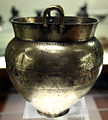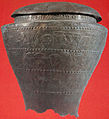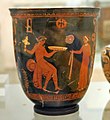Situla

Situla(pluralsitulae), from theLatinword forbucketor pail, is the term in archaeology and art history for a variety of elaborate bucket-shaped vessels from theBronze Ageto theMiddle Ages,usually with a handle at the top. All types may be highly decorated, most characteristically withreliefsinbandsorfriezesrunning round the vessel.
DecoratedIron Agesitulae inbronzeare a distinctive feature ofEtruscan artin burials from the northern part of the Etruscan regions, from which the style spread north to some cultures inNorthern Italy,Slovenia,and adjacent areas, where terms such assitula cultureandsitula artmay be used.
Situla is also the term for types of bucket-shaped Ancient Greek vases, some very finely painted.[1]More utilitarianpotterysitulae are also found, and some insilveror other materials,[2]such as twoglassones fromlate antiquityinSt Mark's, Venice.Ancient Egyptian and Near Eastern shapes tend to have a pointed bottom, so that they must rest on a stand or on their side. The practical wider shape is a European invention, first seen in theEuropean Bronze Age.
Bronze Age Europe
[edit]
Bronze situlae were a feature of theUrnfield culturewhich dominated central Europe and parts of southern Europe in the Late Bronze Age. They frequently incorporated schematic depictions ofsolar boatswith bird headprotomes,known as the 'sun-bird-ship' motif.[4]
Iron Age Europe
[edit]TypicalIron Agesitulae arebronze,as in the types oflibationvessels found asgrave goodsinEtruscan graves,theEste culture(example, theSitula Benvenuti) and neighbouringGolasecca culture,and the eastern zone of theHallstatt cultureof Central and Southeast Europe. Here they have a distinctive style, often without a handle; theVače situlais a Slovenian example. These usually have sides sloping outwards, then a sharp turn in at the shoulder, and outside Etruria often a short narrower neck. The shape has similarities with the narrower spouted Etruscan shape offlagonthat was also copied to the north, as in the 5th-centuryBasse Yutz Flagonsfound in France. They are often decorated, in the most elaborate examples with several bands of figures running round the vessel. They may or may not have handles, and sometimes have lids.[5]Many are made of several sheets held together withrivets.[6]
The Etruscan examples are most characteristic in the 7th century BC, though continuing well afterwards. They are in various materials, from pottery to bronze, and sometimes silver. TheSitula of the Paniais an unusual luxury Etruscan example inivory,and theBocchoris vasea ceramic import from Egypt from an Etruscan burial. The Este and Hallstatt examples are later, with the Slovenian production reaching a peak in quality in the 5th century, up to about 400 BC, well after the Hallstatt period had ended over much of its area.[7]Some were found containing cremated ashes, but they were essentially luxury vessels used at feasts.[8]
Numerous Hallstatt situlae were found in Slovenia, mainly (19 of them) in the area ofNovo MestoinLower Carniola,which has been named the "City of Situlae" due to this.[9][10]Japodian burial urnsmade by theJapodestribe ofIllyriansare a 5th-century BC extension into modernBosniaof this style.
Later Etruscan and then Roman styles favoured a simple shape curving from the base, becoming vertical at the top, with a wide mouth and no shoulder, but sometimes a projecting rim. These had a variety of uses, including for washing and bathing. Any decoration was often concentrated on the upper part of the sides.
Situla art
[edit]Situla art was an important means of transition of Greek-derived motifs from the Etruscans through the regions to the north to the emergingLa Tène culturefurther west.[11]According to Ruth andVincent Megaw,"Situla art depicts life as seen from a masculine viewpoint, in which women are servants or sex objects; most of the scenes which include humans are of the feasts in which the situlae themselves figure, of the hunt or of war".[12]Similar scenes are found on other vessel shapes, as well as bronze belt-plaques.[13]The processions of animals, typical of earlier examples, or humans derive from the Near East and Mediterranean, and Nancy Sandars finds the style shows "agaucheriethat betrays the artist working in a way that is uncongenial, too much at variance with the temper of the craftsmen and the craft ". Compared to earlier styles that arose organically in Europe" situla art is weak and sometimes quaint ", and" in essence not of Europe ".[14]
Except for the Benvenuti Situla, men are hairless, with "funny hats, dumpy bodies and big heads", though often shown looking cheerful in an engaging way. The Benevenuti Situla is also unusual in that it seems to show a specific story.[15]
-
Bronze situla fromHallstatt,800-750 BC
-
Etruscan with geometric ornament, 700-550 BC
-
Etruscan "Situla della Pania",7th century BC
-
Etruscan, silver,Chiusi,c. 650 BC
-
Etruscan, with silver mounts,Cerveteric. 650 BC
-
Clearer reproduction of the Etruscan bronze situla at the top of the page.
-
Situla Benvenuti,Este culture,c. 600 BC
-
Bronze vases & situlae, Eastern zone ofHallstatt cultureD,Kleinklein
-
Golasecca cultureII A, turn of the 7/6th century BC
-
TheVače situla,Slovenia, 5th century BC
-
Late Etruscan, 3rd century BC, bronze
-
Late Etruscan, c. 300 BC, pottery
-
Roman bronze situla from Germany, 2nd-3rd century
-
Ancient Greek (Apulian) pottery situla vase, 340-320 BC
-
Roman silver situla with lady (or Venus) bathing, 190-210 AD
Attribute of Isis
[edit]
The term is also used for pails carried by figures in other art forms; according toPlutarchand other sources this was a sign of a devotee ofIsis,who herself is often shown carrying one (containing water from the sacredNile), of a rather different shape, with a rounded bottom, and sometimes lidded. This rounded shape, often with a "nipple" at the bottom (see Luristan example in§ Gallery,below), is believed to have represented the femalebreast.[16]These were also donated to temples asvotiveofferings by devotees.
Christian situlae
[edit]Elaborateearly medievalsitulae, sometimes calledaspersoria(singular:aspersorium), were Christianliturgicalobjects used to holdholy water,also usually of bronze, and straight-sided with a handle. Anaspergillumwas dipped in the situla to collect water with which to sprinkle the congregation or other objects.
Four richly carvedivoryexamples from the 10th century are known: theBasilewskySitula of 920 in theVictoria & Albert Museum,decorated with twelvescenes from the life of Christon two levels (it contains one of the very few depictions ofJudas Iscariotshowing remorse and throwing the thirty silver coins on the floor of the Temple),[17]the "Situla of Gotofredo" of c. 980 inMilan Cathedral,[18]one in theAachen CathedralTreasury,[19]and one in theMetropolitan Museum of Artin New York.[20]All came from the milieu of theOttoniancourt: an inscription says that Archbishop Gotfredus presented the Milan example in anticipation of a visit by the Emperor,[21]also referred to in the London example which was possibly from the same workshop.[22]The latest and most lavish is the Aachen example, which is studded with jewels and shows an enthroned Emperor, surrounded by a pope and archbishops. This was probably made inTrierabout 1000.[23]
-
The Basilewsky Situla, 920,Ottonian,in ivory
-
Ottonianivory situla with scenes from theLife of Christc. 860-880 AD
Outside Europe
[edit]The term may also be used for similar vessels from other cultures, especially the ancientMiddle Eastand China and Vietnam.[24]
Bronze bath buckets are also found inIslamic art,such as the 12th century PersianBobrinsky Bucketin theHermitage Museum.
-
Situla fromLuristan,9th century BC; note the "nipple" at the bottom
-
Egyptian, 305-30 BC, Ptolemaic Dynasty, bronze
References
[edit]Citations
[edit]- ^MFA Boston, Attic vase situlaArchived2007-02-24 at theWayback Machine
- ^Kipfer, 518
- ^"Situla".Institute for the Study of the Ancient World.2022.
- ^"History of Europe: The People of the Metal Ages – Rituals, religion and art".Britannica.com.Retrieved8 November2022.
In the stylistic development during the Metal Ages, two phenomena are of particular interest. The first is the development of the sun-bird-ship motif of the Urnfield Culture. The origin of this motif, which featured bird-headed ships embellished with solar disks, is not known, but over a short period about 1400 BCE it became common both as incised decoration and as plastic art throughout a vast area of eastern and central Europe. The similarity in execution and composition is remarkable and suggests a shared understanding of its meaning and the intensity of contact between distant areas.
- ^Megaw, 34-39
- ^Sandars, 223
- ^Megaw, 34-39
- ^Sandars, 224
- ^"Novo mesto bogatejše še za eno poslikano situlo"[Novo mesto Richer for Another Painted Situla] (in Slovenian). Lokalno.si. 6 February 2006.Retrieved15 December2010.
- ^"Application for the Title of the European Capital of Culture 2012"(PDF).City Municipality of Maribor. 2008.
{{cite journal}}:Cite journal requires|journal=(help)[permanent dead link] - ^Sandars, 223-225; Megaw, 34-39
- ^Megaw, 37
- ^Sandars, 223-224
- ^Sandars, 225, quoted
- ^Sandars, 224
- ^Witt, 55.Isis situlaArchived2012-02-26 at theWayback Machine
- ^Basilewsky SitulaV&A Museum
- ^"image of Milan situla".Archived fromthe originalon 2014-02-22.Retrieved2010-01-21.
- ^Image of Aachen situlaArchived2011-07-22 at theWayback Machine
- ^Metropolitan Museum example
- ^Lasko, 92-3
- ^Though Lasko, 92 disagrees with this.
- ^All except the New York situla are illustrated and discussed in Beckwith, pp.129-130, 135-136
- ^Metropolitan, Vietnamese bronze situla
Sources
[edit]- Beckwith, John.Early Medieval Art: Carolingian, Ottonian, Romanesque,Thames & Hudson, 1964 (rev. 1969),ISBN0-500-20019-X
- Kipfer, Barbara Ann.Encyclopedic dictionary of archaeology,Springer, 2000,ISBN0-306-46158-7,ISBN978-0-306-46158-3.Google books
- Lasko, Peter,Ars Sacra, 800-1200,Yale University Press, 1995 (2nd edn.)ISBN978-0300060485
- Megaw, Ruth and Vincent,Celtic Art: From Its Beginnings to the Book of Kells,1989 (2001 2nd edn), Thames & Hudson
- Sandars, Nancy K.,Prehistoric Art in Europe,Penguin (Pelican, now Yale, History of Art), 1968 (nb 1st edn.)
- Witt, Reginald Eldred.Isis in the ancient world,JHU Press, 1997 (2nd ed),ISBN0-8018-5642-6,ISBN978-0-8018-5642-6.Google books
Further reading
[edit]- Beckwith, John.The Basilewsky Situla,1963,HMSO
- Frey, Otto-Herman.Die Entstehung der Situlenkunst: Studien zur figürlich verzierten Toreutik von Este,1969.
- Kastelic, Joze, and Karl Kromer, Guido Mansuelli.Situla Art: Ceremonial Bronzes of Ancient Europe,NY McGraw-Hill 1965






















